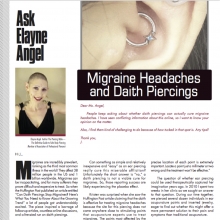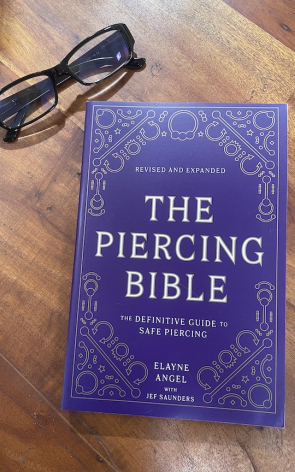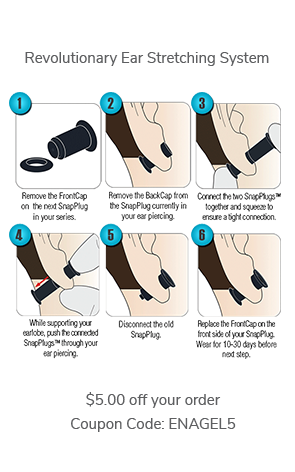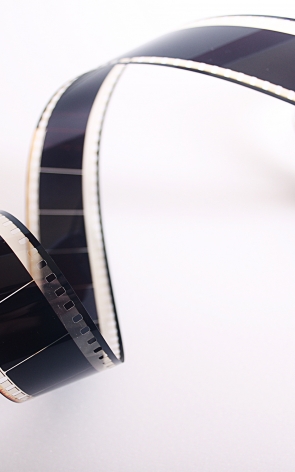Here's the text of an article I wrote for Pain Magazine that appeared in the November 2016 issue. It addresses a question that has come up again and again, from both piercers and piercees: whether a daith piercing can cure migraine headaches.
Migraine Headaches and Daith Piercings
Dear Ms. Angel,
People keep asking about whether daith piercings can actually cure migraine headaches. I have seen conflicting information about this online, so I want to know your opinion on the matter.
Also, I find them kind of challenging to do because of how tucked in that spot is. Any tips?
Thank you,
J.
Hi J.,
Migraines are incredibly prevalent, ranking as the third most common illness in the world! They affect 38 million people in the US and 1 billion worldwide
[i]
. Migraines can be incapacitating, and for many sufferers they prove difficult and expensive to treat. So when the Huffington Post published an article entitled “Can Daith Piercings Stop Migraines? Here’s What You Need to Know About the Growing Trend”
[ii]
a lot of people got understandably excited. The piece inspired a barrage of follow-up articles, countless online discussions, and a frenzied run on daith piercings.
When this subject first came to my attention, I immediately sought the professional opinion of my friend and esteemed colleague, Kristen Horner Warner[iii]. She is a board licensed acupuncturist, an auriculotherapy (ear acupuncture) expert, and also a body piercing enthusiast. We worked closely together on some preliminary research regarding the effectiveness of piercings with body jewelry placed in ear acupuncture points. Below is our shared perspective.
Can something as simple and relatively inexpensive and “easy” as an ear piercing really cure this miserable affliction? Unfortunately the short answer is “no,” a daith piercing is not a viable cure for migraines. So, those reporting success are likely experiencing the placebo effect[iv].
Kristen was surprised when she saw the Huffington Post article claiming that the daith is effective for treating migraine headaches because the site for this piercing does not come anywhere close to stimulating points that acupuncture experts use to treat migraines[v]. The points most affected by the daith piercing are related to the mouth and the anus, which obviously have nothing to do with headaches!
She says, “I have used ear acupuncture to great benefit in my practice for nearly thirteen years. I have found ear acupuncture to be amazingly effective for a wide variety of conditions, including migraines, insomnia, stress, gynecological problems, sciatica, joint pain, and many others. There are dozens of acupuncture points in the outer ear and the precise location of each point is extremely important. Locate a point just a millimeter or two wrong and the treatment won’t be effective.”
The question of whether ear piercing could be used therapeutically captured her imagination years ago. In 2010 I spent two weeks in her clinic as we sought an answer to that question. During our time together, we pierced several dozen individuals in ear acupuncture points and inserted jewelry, eager to find out whether this might offer a more permanent solution to their pain and symptoms than traditional acupuncture.
Kristen then followed those patients, tracking any reported benefits or side effects from the piercings. Although our experiment did not follow the scientific method, it provided some clear clinical evidence that is directly relevant to this topic:
“Without exception, patients who noticed a therapeutic benefit to their piercings reported that that effect disappeared within a month. In many cases the improvement lasted only a week or two. This is about the same amount of time that the benefit from ear seeds[vi] lasts, but ear seeds [small pellets affixed with tape] have the advantage of being painless and carry none of the risks associated with piercings,” Kristen explained.
When she and I first met, Kristen wore a daith piercing that she got because she loved the look of it, not because she had any trouble with headaches. But the poor placement and nicked up jewelry in it drove me to distraction. I eventually talked her into abandoning it, because I could see that it would never heal properly. Every time that jewelry moved even slightly, it was causing irritation. And for this piercing, some movement is to be expected with facial expressions, chewing, and speaking. The scratched jewelry also increased her risk of infection, as bacteria can lodge in irregular surfaces.
The daith is credited to piercer Erik Dakota who says its name, which rhymes with “moth,” comes from the ancient Hebrew word da’at, meaning “knowledge.” This has become somewhat ironic given the amount of misinformation now being spread in the name of the daith.
It is an advanced piercing that is often placed incorrectly. And because cartilage doesn’t have its own blood supply, these piercings are already harder to heal than those in many other areas of the body. The daith should be seated into the most recessed portion of the ear, at the root of the helix crus, which does make it challenging to do properly. Most ears are configured with a pierceable crest at this location. When situated properly, according to Dakota, the lower part of the jewelry seems to come directly out of the ear canal.
Because the surrounding region is comprised of hard cartilage, it forms a sort of barrier that blocks easy access to the correct spot. Between the difficulty presented by the anatomy and the fact that many piercers do not have sufficient training, daith piercings are often placed too superficially. I also regularly see daith piercings with jewelry that is overly large so it gets caught up on surrounding structures leading to complications. A bungled job is likely to result in unnecessary pain, irritation, and serious healing problems including unsightly excess scar tissue causing (sometimes permanent) bumps around the openings, and a higher likelihood of migration and rejection.
At the exit, I use a small receiving tube, usually with a 45-degree angled end. A short or bent tube may be needed to fit in the limited space. Before piercing, I always perform a technique I refer to as “tissue manipulation.” It helps to prepare the area and securely seat the tube so that it does not slip during the piercing. I place a sterile swab (or the back end of a wooden swab’s post) at the entry point and put the tube into position at the exit. I then apply moderate pressure from both sides while massaging in a barely perceptible circular motion. I find this to be very helpful for all receiving tube procedures that are done on cartilage—and also for septum piercings.
Some piercers use a curved needle in this region. If one will be used, it must have a smooth arc and no kinks or burrs. Hemostats can be helpful to handle the jewelry for insertion and closure, but brass-jaw tools may be needed to avoid damage—especially with gold, which is quite soft when compared with steel and titanium. Always use smooth-jaw instruments on jewelry, rather than serrated.
When it comes to piercings of acupuncture points, clinical experience demonstrates that body piercings do not represent a long-term cure for any condition. And, of course piercers who are not medical professionals are prohibited by law from making any health claims about the piercings we do. Not only is a daith piercing highly unlikely to help, but by asserting that they treat or cure migraines, you could be charged with practicing medicine without a license.
For a fantastic article about daith piercings, read Jef Saunders’ blog,[vii] “Confessions of a Piercing Nerd.” Download the article here.





